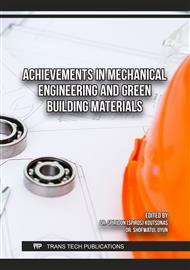[1]
G. Redkina, A. Sergienko, and Y. I. Kuznetsov, "Hydrophobic and anticorrosion properties of thin phosphonate-siloxane films formed on a laser textured zinc surface," International Journal of Corrosion and Scale Inhibition, vol. 9, no. 4, pp.1550-1563, 2020.
DOI: 10.17675/2305-6894-2020-9-4-23
Google Scholar
[2]
P. S. Kumar and S. Acharyya, "Controlling chloride induced stress corrosion cracking of AISI 316L stainless steel by application of buffing," Materials Today: Proceedings, vol. 15, pp.138-144, 2019.
DOI: 10.1016/j.matpr.2019.05.036
Google Scholar
[3]
A. Weisenburger et al., "Long term corrosion on T91 and AISI1 316L steel in flowing lead alloy and corrosion protection barrier development: Experiments and models," Journal of Nuclear Materials, vol. 415, no. 3, pp.260-269, 2011.
DOI: 10.1016/j.jnucmat.2011.04.028
Google Scholar
[4]
V. A. Andrei et al., "Applications of plasma electrolytic saturation technique in the field of nuclear materials," J. Sci. Arts, vol. 1, pp.185-194, 2019.
Google Scholar
[5]
R. Sánchez-Tovar, M. Montañés, J. Garcia-Anton, and A. Guenbour, "Influence of temperature and hydrodynamic conditions on the corrosion behavior of AISI 316L stainless steel in pure and polluted H3PO4: Application of the response surface methodology," Materials Chemistry and Physics, vol. 133, no. 1, pp.289-298, 2012.
DOI: 10.1016/j.matchemphys.2012.01.024
Google Scholar
[6]
R. W. Phillips, "Skinner's science of dental materials," W. B. Saunders Company, xii+ 682, 26 x 18 cm, illustrated, 1973, 1973.
Google Scholar
[7]
G. Duffo and E. Q. Castillo, "Development of an artificial saliva solution for studying the corrosion behavior of dental alloys," Corrosion, vol. 60, no. 6, pp.594-602, 2004.
DOI: 10.5006/1.3287764
Google Scholar
[8]
J. Meyer and J. Nally, "Influence of artificial salivas on corrosion of dental alloys," in Journal of Dental Research, 1975, vol. 54, no. 3: AMER ASSOC DENTAL RESEARCH 1619 DUKE ST, ALEXANDRIA, VA 22314, pp.678-678.
Google Scholar
[9]
W. Aperador, J. Bautista-Ruiz, and E. Delgado, "Hot corrosion resistance of Al2O3 coating produced by thermal spray," Int. J. Electrochem. Sci, vol. 11, pp.9424-9437, 2016.
DOI: 10.20964/2016.11.44
Google Scholar
[10]
R. A. Jassim, A. M. Farhan, and A. M. Ali, "Corrosion protection study of carbon steel and 316 stainless steel alloys coated by nanoparticles," Baghdad Science Journal, vol. 11, no. 1, pp.116-122, 2014.
DOI: 10.21123/bsj.2014.11.1.116-122
Google Scholar
[11]
Y. Shen, X. Guo, Y. Lin, and J. Tao, "Al2O3 coatings fabricated on stainless steel/aluminium composites by microarc oxidation," Surface Engineering, vol. 30, no. 10, pp.735-740, 2014.
DOI: 10.1179/1743294414y.0000000300
Google Scholar
[12]
M. Fedel and F. Deflorian, "Electrochemical characterization of atomic layer deposited Al2O3 coatings on AISI 316L stainless steel," Electrochimica Acta, vol. 203, pp.404-415, 2016.
DOI: 10.1016/j.electacta.2016.02.107
Google Scholar
[13]
S. Said, S. Mikhail, and M. Riad, "Recent processes for the production of alumina nano-particles," Materials Science for Energy Technologies, vol. 3, pp.344-363, 2020.
DOI: 10.1016/j.mset.2020.02.001
Google Scholar
[14]
S. Wang, X. Li, S. Wang, Y. Li, and Y. Zhai, "Synthesis of γ-alumina via precipitation in ethanol," Materials Letters, vol. 62, no. 20, pp.3552-3554, 2008.
DOI: 10.1016/j.matlet.2008.03.048
Google Scholar
[15]
F.A. Al-Sanabani, A. A. Madfa, and N. H. Al-Qudaimi, "Alumina ceramic for dental applications: A review article," Am. J. Mater. Res, vol. 1, no. 1, pp.26-34, 2014.
Google Scholar
[16]
P. Xu, C. Lin, C. Zhou, and X. Yi, "Wear and corrosion resistance of laser cladding AISI 304 stainless steel/Al2O3 composite coatings," Surface and Coatings Technology, vol. 238, pp.9-14, 2014.
DOI: 10.1016/j.surfcoat.2013.10.028
Google Scholar
[17]
S. Bajpai, A. Gupta, S. K. Pradhan, T. Mandal, and K. Balani, "Crack Propagation Resistance of α-Al 2 O 3 Reinforced Pulsed Laser-Deposited Hydroxyapatite Coating on 316 Stainless Steel," Jom, vol. 66, pp.2095-2107, 2014.
DOI: 10.1007/s11837-014-1152-3
Google Scholar
[18]
V.A. Andrei et al., "Aluminum oxide ceramic coatings on 316L austenitic steel obtained by plasma electrolysis oxidation using a pulsed unipolar power supply," Coatings, vol. 10, no. 4, p.318, 2020.
DOI: 10.3390/coatings10040318
Google Scholar


